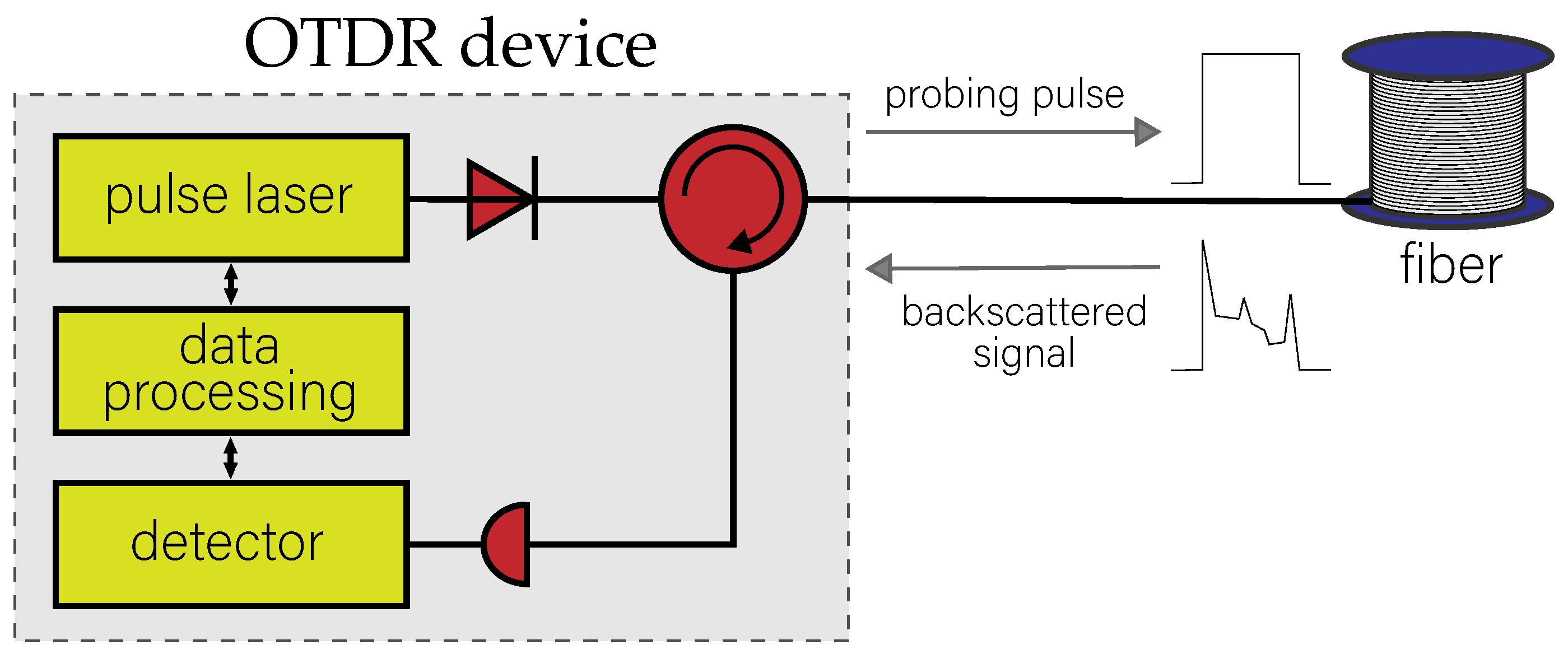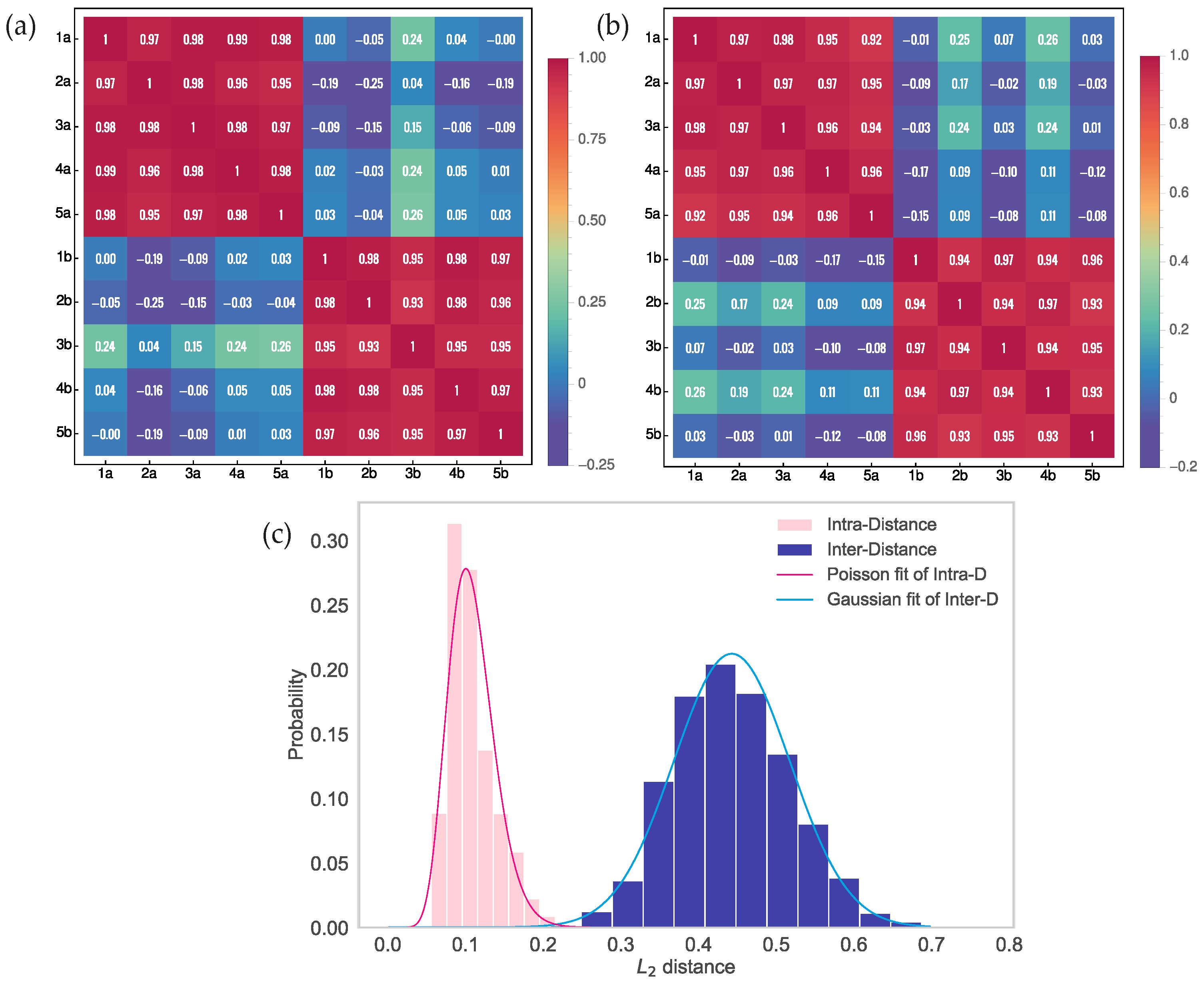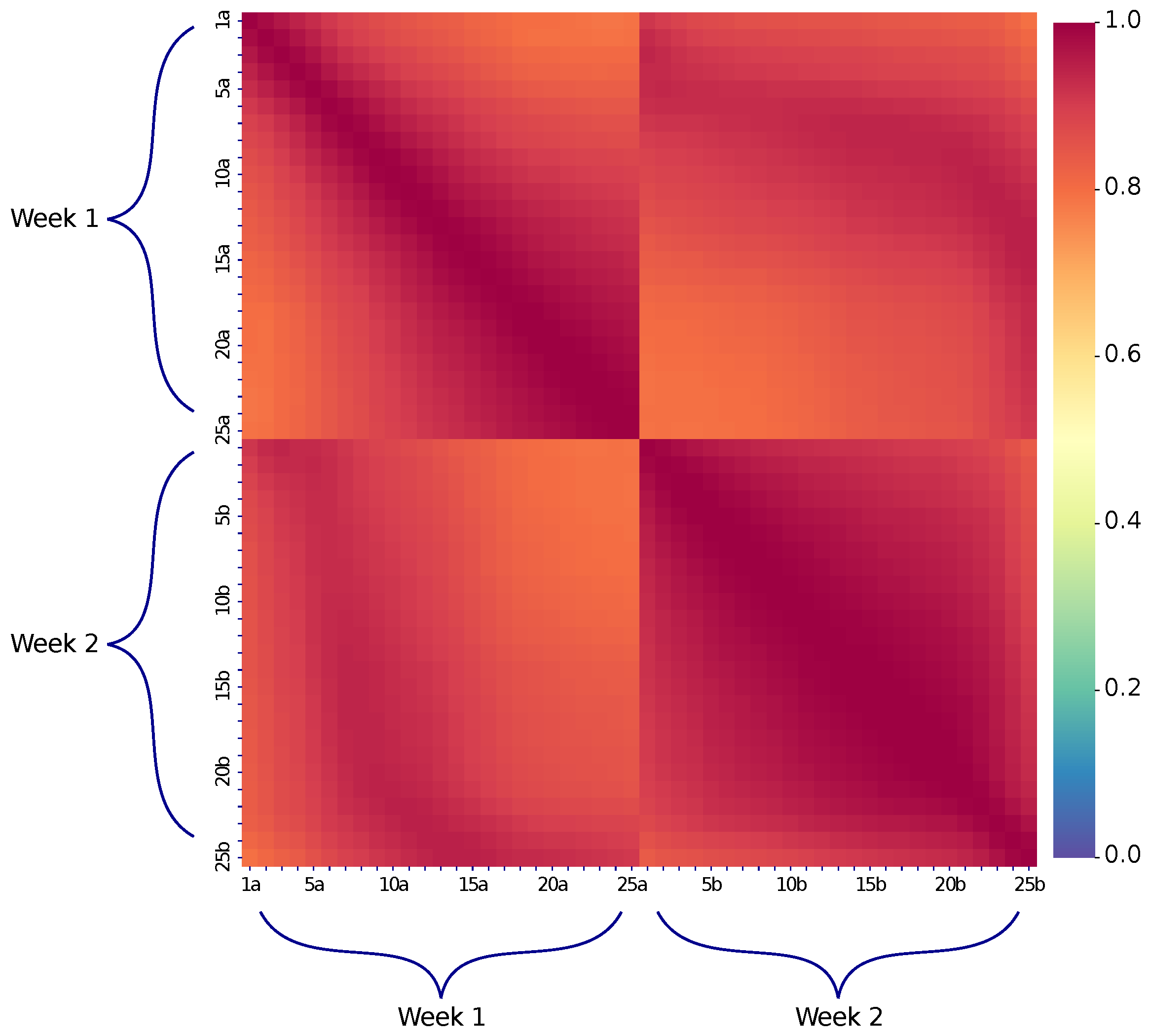An Optical-Fiber-Based Key for Remote Authentication of Users and Optical Fiber Lines
Abstract
1. Introduction
2. Method Description
3. Results
3.1. Theoretical Analysis
3.2. Experimental Verification of Fiber Key Uniqueness and Reproducibility
3.3. Spatial Frequencies Spectrum Investigation
4. Discussion
- The user first carries out OTDR measurements with a large variety of available challenge pulses to form a challenge–response pair database in digitized form.
- To authenticate an optical line, a legitimate user needs to carry out OTDR measurements with randomly selected challenge pulse(s) from their database and collect response(s).
- The user then takes an appropriate mathematical comparison method (e.g., correlation metrics, Hamming distance, distance) for their response(s) and obtains the result of whether the authentication is successful.
- Both Alice and Bob, with their OTDR devices, carry out in advance numerous measurements of each other’s unique fiber samples with a wide variety of probing pulse parameters, i.e., form two databases of challenge–response pairs [2].
- For Alice to authenticate Bob, he connects their unique fiber sample to the receptacle. Then, Alice randomly selects challenge–response pair(s) from her database and sends the light pulses with corresponding parameters to Bob.
- In the case of correct response in terms of the chosen method of mathematical comparison, Bob authenticates Alice the same way.
- In the case of correct responses from both sides, authentication is successful.
5. Conclusions
Author Contributions
Funding
Institutional Review Board Statement
Informed Consent Statement
Data Availability Statement
Acknowledgments
Conflicts of Interest
References
- Wu, B.; Shastri, B.J.; Prucnal, P.R. Chapter 11—Secure Communication in Fiber-Optic Networks. In Emerging Trends in ICT Security; Akhgar, B., Arabnia, H.R., Eds.; Morgan Kaufmann: Boston, MA, USA, 2014; pp. 173–183. [Google Scholar] [CrossRef]
- Maes, R.; Verbauwhede, I. Physically Unclonable Functions: A Study on the State of the Art and Future Research Directions. In Towards Hardware-Intrinsic Security: Foundations and Practice; Springer: Berlin/Heidelberg, Germany, 2010; pp. 3–37. [Google Scholar] [CrossRef]
- McGrath, T.; Bagei, I.E.; Wang, Z.M.; Roedig, U.; Young, R.J. A PUF taxonomy. Appl. Phys. Rev. 2019, 6, 011303. [Google Scholar] [CrossRef]
- Wan, Y.; Pidong, W.; Huang, F.; Yuan, J.; Li, D.; Chen, K.; Kang, J.; Li, Q.; Zhang, T.; Sun, S.; et al. Bionic optical physical unclonable functions for authentication and encryption. J. Mater. Chem. C 2021, 9, 13200–13208. [Google Scholar] [CrossRef]
- Arppe-Tabbara, R.; Sørensen, T. Physical unclonable functions generated through chemical methods for anti-counterfeiting. Nat. Rev. Chem. 2017, 1, 0031. [Google Scholar] [CrossRef]
- Cao, Y.; Robson, A.; Alharbi, A.; Roberts, J.; Woodhead, C.; Noori, Y.; Bernardo-Gavito, R.; Shahrjerdi, D.; Roedig, U.; Falko, V.; et al. Optical identification using imperfections in 2D materials. 2D Mater. 2017, 4, 045021. [Google Scholar] [CrossRef]
- Kim, M.S.; Lee, G.J.; Choi, S.H.; Leem, J.W.; Kim, Y.L.; Song, Y.M. Lensless and Optical Physically Unclonable Function with Fibrous Media. In Proceedings of the 2021 Conference on Lasers and Electro-Optics Europe and European Quantum Electronics Conference, Munich, Germany, 21–25 June 2021. [Google Scholar]
- Mesaritakis, C.; Akriotou, M.; Kapsalis, A.; Grivas, E.; Chaintoutis, C.; Nikas, T.; Syvridis, D. Physical Unclonable Function based on a Multi-Mode Optical Waveguide. Sci. Rep. 2018, 8, 9653. [Google Scholar] [CrossRef] [PubMed]
- Masataka, N. Rayleigh backscattering theory for single-mode optical fibers. J. Opt. Soc. Am. 1983, 73, 1175–1180. [Google Scholar] [CrossRef]
- Froggatt, M.; Soller, B.; Gifford, D.; Wolfe, M. Correlation and Keying of Rayleigh Scatter for Loss and Temperature Sensing in Parallel Optical Networks. In Proceedings of the Optical Fiber Communication Conference, Los Angeles, CA, USA, 23–27 February 2004; p. PD17. [Google Scholar]
- Froggatt, M.E.; Gifford, D.K. Rayleigh backscattering signatures of optical fibers—Their properties and applications. In Proceedings of the 2013 Optical Fiber Communication Conference and Exposition and the National Fiber Optic Engineers Conference (OFC/NFOEC), Anaheim, CA, USA, 17–21 March 2013; pp. 1–3. [Google Scholar]
- Gifford, D.K.; Froggatt, M.E. Rayleigh Scatter Based High Resolution Distributed Fiber Sensing for Safety and Security Applications. In Proceedings of the Frontiers in Optics 2013, Orlando, FL, USA, 6–10 October 2013; p. FW4I.2. [Google Scholar] [CrossRef]
- Du, Y.; Jothibasu, S.; Zhuang, Y.; Zhu, C.; Huang, J. Unclonable Optical Fiber Identification Based on Rayleigh Backscattering Signatures. J. Light. Technol. 2017, 35, 4634–4640. [Google Scholar] [CrossRef]
- Nadimi Goki, P.; Mulugeta, T.T.; Caldelli, R.; Potì, L. Optical Systems Identification through Rayleigh Backscattering. Sensors 2023, 23, 5269. [Google Scholar] [CrossRef] [PubMed]
- Nadimi Goki, P.; Civelli, S.; Parente, E.; Caldelli, R.; Mulugeta, T.T.; Sambo, N.; Secondini, M.; Potì, L. Optical identification using physical unclonable functions. arXiv 2023. [Google Scholar] [CrossRef]
- Yao, Z.; Mauldin, T.; Hefferman, G.; Xu, Z.; Liu, M.; Wei, T. Low-cost optical fiber physical unclonable function reader based on a digitally integrated semiconductor LiDAR. Appl. Opt. 2019, 58, 6211–6216. [Google Scholar] [CrossRef] [PubMed]
- MacDonald, R.I. Frequency domain optical reflectometer. Appl. Opt. 1981, 20, 1840–1844. [Google Scholar] [CrossRef] [PubMed]
- Azadeh, M. Fiber Optic Communications: A Review. In Fiber Optics Engineering; Springer: Boston, MA, USA, 2009; pp. 1–27. [Google Scholar] [CrossRef]
- Barnoski, M.K.; Rourke, M.D.; Jensen, S.M.; Melville, R.T. Optical time domain reflectometer. Appl. Opt. 1977, 16, 2375–2379. [Google Scholar] [CrossRef]
- Mauldin, T.; Xu, Z.; Yao, Z.; Wei, T. Integrated optical time-domain reflectometer with low overhead. Appl. Opt. 2020, 59, 5473–5480. [Google Scholar] [CrossRef]
- Brinkmeyer, E. Analysis of the backscattering method for single-mode optical fibers. J. Opt. Soc. Am. 1980, 70, 1010–1012. [Google Scholar] [CrossRef]
- Hartog, A.; Gold, M. On the theory of backscattering in single-mode optical fibers. J. Light. Technol. 1984, 2, 76–82. [Google Scholar] [CrossRef]
- Alekseev, A.E.; Tezadov, Y.A.; Potapov, V.T. The influence of the degree of coherence of a semiconductor laser on the statistic of the backscattered intensity in a single-mode optical fiber. J. Commun. Technol. Electron. 2011, 56, 1490–1498. [Google Scholar] [CrossRef]





Disclaimer/Publisher’s Note: The statements, opinions and data contained in all publications are solely those of the individual author(s) and contributor(s) and not of MDPI and/or the editor(s). MDPI and/or the editor(s) disclaim responsibility for any injury to people or property resulting from any ideas, methods, instructions or products referred to in the content. |
© 2023 by the authors. Licensee MDPI, Basel, Switzerland. This article is an open access article distributed under the terms and conditions of the Creative Commons Attribution (CC BY) license (https://creativecommons.org/licenses/by/4.0/).
Share and Cite
Smirnov, A.; Yarovikov, M.; Zhdanova, E.; Gutor, A.; Vyatkin, M. An Optical-Fiber-Based Key for Remote Authentication of Users and Optical Fiber Lines. Sensors 2023, 23, 6390. https://doi.org/10.3390/s23146390
Smirnov A, Yarovikov M, Zhdanova E, Gutor A, Vyatkin M. An Optical-Fiber-Based Key for Remote Authentication of Users and Optical Fiber Lines. Sensors. 2023; 23(14):6390. https://doi.org/10.3390/s23146390
Chicago/Turabian StyleSmirnov, Alexander, Mikhail Yarovikov, Ekaterina Zhdanova, Alexander Gutor, and Mikhail Vyatkin. 2023. "An Optical-Fiber-Based Key for Remote Authentication of Users and Optical Fiber Lines" Sensors 23, no. 14: 6390. https://doi.org/10.3390/s23146390
APA StyleSmirnov, A., Yarovikov, M., Zhdanova, E., Gutor, A., & Vyatkin, M. (2023). An Optical-Fiber-Based Key for Remote Authentication of Users and Optical Fiber Lines. Sensors, 23(14), 6390. https://doi.org/10.3390/s23146390






